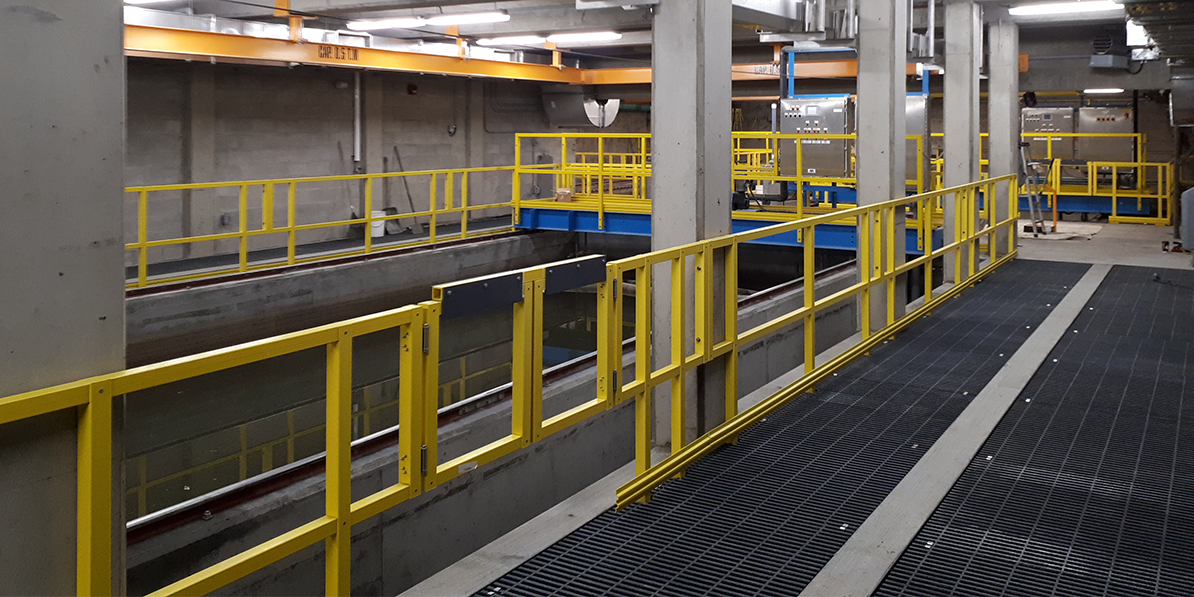Choosing materials that are adapted to specific requirements and environments is no easy task. For this reason, we have put together a list of four questions to consider when selecting materials for your structures, catwalks, and ladders. These questions will also ensure that the chosen materials are adapted to the environment in which they need to perform. This will not only ensure optimal service life but also lower maintenance costs for your structures.
 1. Will the structure be exposed to highly corrosive environments?
1. Will the structure be exposed to highly corrosive environments?
Determining the structure’s general environment is a key step in choosing the right materials. Metals are unsuitable for structures exposed to chemicals or that require frequent cleaning. Indeed, the presence of humidity or chemical products causes metal structures to degrade prematurely. The most appropriate solution is to choose FRP gratings, which are not only resistant to chemicals and corrosion but also strong enough to tolerate aggressive cleaning. FPR performs well while maintaining its strength and continuing to provide excellent resistance properties. Furthermore, this material is known for having a long service life.
 Evidently, water and humidity promote the appearance of rust, which is a plague for metal structures. Although metal can be repainted, polished and treated to maximize its service life, it is better to opt for materials that do not rust. FRP is perfectly adapted to humid environments and is used in the fabrication of structures in wastewater treatment plants. FRP is also frequently used to manufacture platforms for chemical plants and submerged ladders used in saline environments.
Evidently, water and humidity promote the appearance of rust, which is a plague for metal structures. Although metal can be repainted, polished and treated to maximize its service life, it is better to opt for materials that do not rust. FRP is perfectly adapted to humid environments and is used in the fabrication of structures in wastewater treatment plants. FRP is also frequently used to manufacture platforms for chemical plants and submerged ladders used in saline environments.
In essence, FRP does not oxidize like steel and other traditional materials. Moreover, it never loses its pigmentation, as it is not painted; its colour comes from the pigmentation found in the base resin that constitutes it.
 2. Is there a risk of falls or accidents?
2. Is there a risk of falls or accidents?
For work environments with a particularly high risk of falls, choose materials with excellent anti-slip properties, even when wet. The use of an anti-slip coating is another efficient solution to reduce the risk of falls. Moreover, installing solid guardrails that are safe for workers can also prevent lower-level falls.
 3. Is the structure used in a high-voltage industrial environment?
3. Is the structure used in a high-voltage industrial environment?
This variable must obviously be considered, as the risk of electrocution is even greater in industrial environments that use high voltages. Unlike metals, which are generally highly conductive, FRP is an excellent electrical insulator and is therefore ideal for structures or ladders installed in hazardous environments or near a power source. FRP will protect workers that use platforms, elevated platforms, and ladders, even in environments with high electrical hazards.
 4. Will the structure be used in a food environment?
4. Will the structure be used in a food environment?
Whether it is at the production, processing, or packaging level, materials used in the food industry should always be chosen carefully, and structures are no exception.
Structures used in the food industry must meet certain standards and be able to withstand frequent cleaning. FRP is approved by Agriculture Canada for use in the food industry and is therefore safe to use. It also is not affected by frequent cleaning and sanitation.
In summary, analyzing these four questions will help guide you through the choice of materials that are adapted to your situation. However, structures are only one of the key elements that must be assessed to create a safer environment. Other factors that can have a direct impact on worker safety, such as decibel levels, also need to be considered.
To learn more about key elements to ensure a safer work environment, see our article: Three Key Elements for a Safer Factory Environment.








